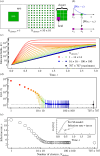Predicting the effect of landscape structure on epidemic invasion using an analytical estimate for infection rate
- PMID: 39780974
- PMCID: PMC11706665
- DOI: 10.1098/rsos.240763
Predicting the effect of landscape structure on epidemic invasion using an analytical estimate for infection rate
Abstract
The influence of landscape structure on epidemic invasion of agricultural crops is often underestimated in the construction and analysis of epidemiological models. Computer simulations of individual-based models (IBMs) are widely used to characterize disease spread under different management scenarios but can be slow in exploring large numbers of different landscape configurations. Here, we address the problem of finding an analytical measure of the impact of the spatial structure of a crop landscape on the invasion and spread of plant pathogens. We explore the potential of using an analytical approximation for the rate, , at which susceptible crop fields become infected at the start of an epidemic to predict the effect that the spatial structure of a host landscape will have on an epidemic. We demonstrate the validity of this approach using two models: (i) a general IBM of the invasion and spread of a pathogen through an abstract host landscape; and (ii) an IBM of a real-life example for a virus disease spreading through a cassava landscape. Finally, we demonstrate that the analytical approach based on an estimate of the rate, , can be used to identify spatial structures that effect deceleration of an invading pathogen.
Keywords: analytical approximation; crop landscape; epidemic invasion; epidemiological model; infection rate; spatially explicit individual-based model.
© 2025 The Authors.
Conflict of interest statement
We declare we have no competing interests.
Figures






References
-
- Grass I, et al. . 2019. Land‐sharing/‐sparing connectivity landscapes for ecosystem services and biodiversity conservation. People Nat. 1, 262–272. (10.1002/pan3.21) - DOI
-
- Segre H, Carmel Y, Shwartz A. 2022. Economic and not ecological variables shape the sparing–sharing trade‐off in a mixed cropping landscape. J. Appl. Ecol. 59, 779–790. (10.1111/1365-2664.14092) - DOI
-
- Correa Ayram CA, Mendoza ME, Etter A, Salicrup DRP. 2016. Habitat connectivity in biodiversity conservation. Prog. Phys. Geogr. 40, 7–37. (10.1177/0309133315598713) - DOI
Associated data
LinkOut - more resources
Full Text Sources
